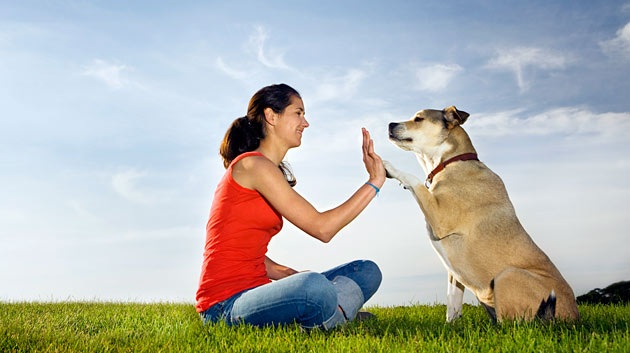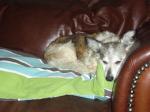Dog Training 101: Your Guide To A Better Pooch
Are you fed up with a bad dog? If this is the case, your dog might require further training. Investing extra training time into your dog will make him more obedient. The excellent tips in this article can get you started.
 Play with your dog often. In order to train your dog efficiently, it is important to develop and nurture a bond between the two of you. Make sure you are taking the time out of your day to play with your dog. It will be fun and stress-reducing for both of you.
Play with your dog often. In order to train your dog efficiently, it is important to develop and nurture a bond between the two of you. Make sure you are taking the time out of your day to play with your dog. It will be fun and stress-reducing for both of you.As you plan out your dog training sessions, focus on only teaching your pet one new skill at a time. Too many instructions and expectations can cause your dog to become confused and frustrated. You will achieve much better results if you work on one skill, achieve mastery and then move on.
Always end a training session with your dog on a positive note, even if you have to manipulate the scenario to make your dog successful. Ending a training session immediately after a disciplinary action will mean that your dog will remember the session as being about punishment, not about training.
The basics of training your dog involve rationing food and physically showing the dog what to do. By rationing the food your dog gets throughout the day, you can use treats during training more effectively. By physically moving the dog you can "force" the dog to understand what you intend the dog to do, in response to a certain command.
Avoid saying 'no' during dog training. Find positive and supportive ways to train your furry friend. Saying 'no' is not a good command, and the dog won't know how to react. All dogs are different and will respond to different training.
Use your puppy's name often so that he knows to pay attention when you speak. Use his name more when he is a puppy. By the time he is grown, he will automatically give you his attention when you say his name. Choose a puppy name that sounds differently than other words your puppy may hear throughout the day.
A good dog training tip is to be consistent with the words you use when you communicate with your dog. English is a foreign language to dogs and they're constantly trying to decipher what you're saying. By being consistent with your words, your dog will be more likely to learn.
When you train your dog it is important to reinforce every example of behavior you want to encourage. Whenever your pet behaves according to your wishes it should be rewarded. This will prevent your dog from becoming confused and establish positive reinforcement associations. Behavior that is rewarded is behavior that will be repeated and eventually become habitual.
Sometimes a dog trainer must punish their dog. Punishment does not eliminate the behavior the trainer wants to discourage, though; it merely suppresses it. Canny trainers know that punishing a dog only encourages them to hide the behavior for which they are being punished. It is better to entirely replace an undesirable behavior than to punish a pet for engaging in it.
One tip to keep in mind when training a dog is to ensure that you make it absolutely clear to your dog what it is that your are disciplining it for. This is important to avoid confusion and to teach the dog what is desired and what is undesired behavior. An example of what to avoid is hitting your dog hours past and in a different room from where it shredded your couch.
A well-trained pet is more relaxing and fun with which to spend time. It may feel right now like your dog is incapable of behaving, but with training, you'll be very surprised. By remembering these things, you will be more successful in your endeavors.
http://trainadogonline.com/?temp-new-window-replacement=true
Dogs Don't Know The Rules, So We Need To Teach Them!
For anyone who is new to dog training, there are certainly some challenges to overcome. In a lot of cases, you could encounter one of those stubborn pups who just don't want to listen, at which point you need the strategies of the pros at your disposal. Use these tips to learn more about taking on dog training, with an edge that won't fail.
Tricks
 There are many ways to make crate training more comfortable and successful for your new puppy or dog. To entice a hesitant puppy into the crate, give it the incentive of a toy or bone inside, with the door shut. Your dog will want the bone and will be unable to resist entering the crate. If they do go into the crate, offer up praise and a treat.
There are many ways to make crate training more comfortable and successful for your new puppy or dog. To entice a hesitant puppy into the crate, give it the incentive of a toy or bone inside, with the door shut. Your dog will want the bone and will be unable to resist entering the crate. If they do go into the crate, offer up praise and a treat.If you are getting a new dog, and you intend to train it, look for a younger dog. The old adage "You can't teach an old dog new tricks" is somewhat appropriate here. Younger dogs are more receptive to dominance from a pack leader and will learn quickly in an effort to please. Another plus to this is that young dogs really enjoy learning new things, much like children do.
If there is a behavior you'd like your dog to be able to do on command, make sure you praise him whenever he offers this behavior. This works well for tricks that you are actively teaching, as well as actions that he does naturally. For instance, if you think it would be fun to teach your dog to sneeze whenever you ask, simply say, "Sneeze," and treat him whenever he does sneeze. Sooner or later, he will learn the association between the word "sneeze," the action of sneezing, and the reward.
To successfully train your dog, start by making sure to use its name when you call it. Call your pet by name for feedings, walks and play, but never for punishment. This ensures that you will be able to get your dog's attention once you begin asking for more complex tricks.
When training your dog make sure you never stop training. This may sound silly but it is actually very sensible. Your dog may learn tricks quickly and not forget them, but dogs never stop learning so you need to take advantage of this by teaching often. Also, it never hurts to reinforce what has already been learned.
Teach your dog the basics before trying to teach them more complicated "fun" tricks. It is important to have the basic obedience skills, such as sit, stay, lie down, and come learned before you try teaching tricks like shake and roll over. Although it is tempting just to jump to the fun stuff, having a firm grasp on the basic commands will make learning tricks much easier.
Your command should be the final command, and your pup has to learn. However, that doesn't mean he is going to take the training and get it, immediately. You need to know the special tricks and get some good advice. The tips of this article can serve as a great point to start from, so that your dog training can go the way you want it to.
If you are looking for ways to help your dogs with their training, we can help you find the best professionals to help you. We are always ready to provide the training services that you need for your dogs. Continue reading to find out more.
